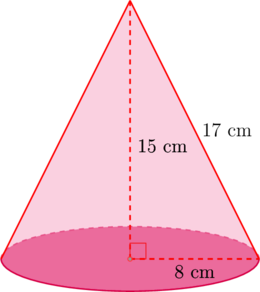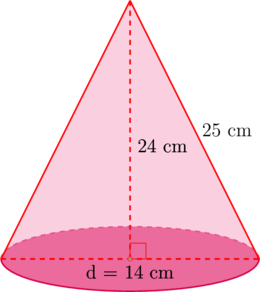\(\color{blue}\text{Luas Permukaan Kerucut} = \pi \text{r}(\text{r} + \text{s})\)
\(\text{r} = \text{jari – jari}\)
\(\text{s} = \text{panjang garis pelukis}\)
CONTOH SOAL
Soal 1
Perhatikan gambar berikut:

Tentukan luas permukaan kerucut di atas. (Gunakan \(\pi = 3,14\))
Panjang garis pelukis (s) = 17 cm
Jari-jari alas (r) = 8 cm
\(\text{Luas permukaan kerucut} = \pi \text{r}(\text{r} + \text{s})\)
\(\text{Luas permukaan kerucut} = 3,14\cdot 8 (8 + 17)\)
\(\text{Luas permukaan kerucut} = 3,14\cdot 8 (25)\)
\(\text{Luas permukaan kerucut} = 3,14\cdot 200\)
\(\text{Luas permukaan kerucut} = 628 \text{ cm}^2\)
Soal 2
Perhatikan gambar berikut:

Tentukan luas permukaan kerucut di atas. (Gunakan \(\pi = \dfrac{22}{7}\))
Panjang garis pelukis (s) = 25 cm
Jari-jari alas (r) = 14 ÷ 2 = 7 cm
\(\text{Luas permukaan kerucut} = \pi \text{r}(\text{r} + \text{s})\)
\(\text{Luas permukaan kerucut} = \dfrac{22}{7}\cdot 7 (7 + 25)\)
\(\text{Luas permukaan kerucut} = \dfrac{22}{\cancel{7}}\cdot \cancel{7} (32)\)
\(\text{Luas permukaan kerucut} = 704 \text{ cm}^2\)
